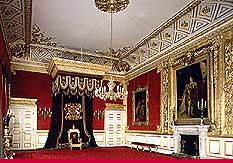|
 St James's Palace: The Throne Room, used for official occasions. In this room, the Lord Mayor and Councillors of the City of Westminster present an address of welcome to visiting Heads of State on State Visits
© Royal Collection |
|
|
The senior Palace of the Sovereign and still the 'Court' to which foreign Ambassadors and High Commissioners are accredited, St James's Palace was built between 1532 and 1540 by Henry VIII on the site of the Hospital of St James, Westminster. For over 300 years it was lived in by Kings and Queens of England. From the time when Queen Anne brought the court to St James's in 1702 after the disastrous fire which destroyed the Palace of Whitehall in 1698, it has remained the official residence of the Sovereign, although since the death of William IV in 1837, the Sovereign has lived at Buckingham Palace.
It was in St James's Palace that Mary Tudor signed the treaty surrendering Calais. Elizabeth I was resident there during the Spanish Armada and set out from St James's to address the troops assembled at Tilbury Camp. Charles I was confined to the Palace before his execution in January 1649.
Today St James's Palace contains the London residences of The Prince of Wales, and Princess Alexandra and Sir Angus Ogilvy. The offices of The Prince of Wales, the Royal Collection, the Marshal of the Diplomatic Corps, the Central Chancery of the Orders of Knighthood, the Chapel Royal are all located in the Palace. Clarence House, the London home of Queen Elizabeth The Queen Mother, is within the St James's Palace environs, as is Lancaster House which is used for government conferences and receptions. |
|

